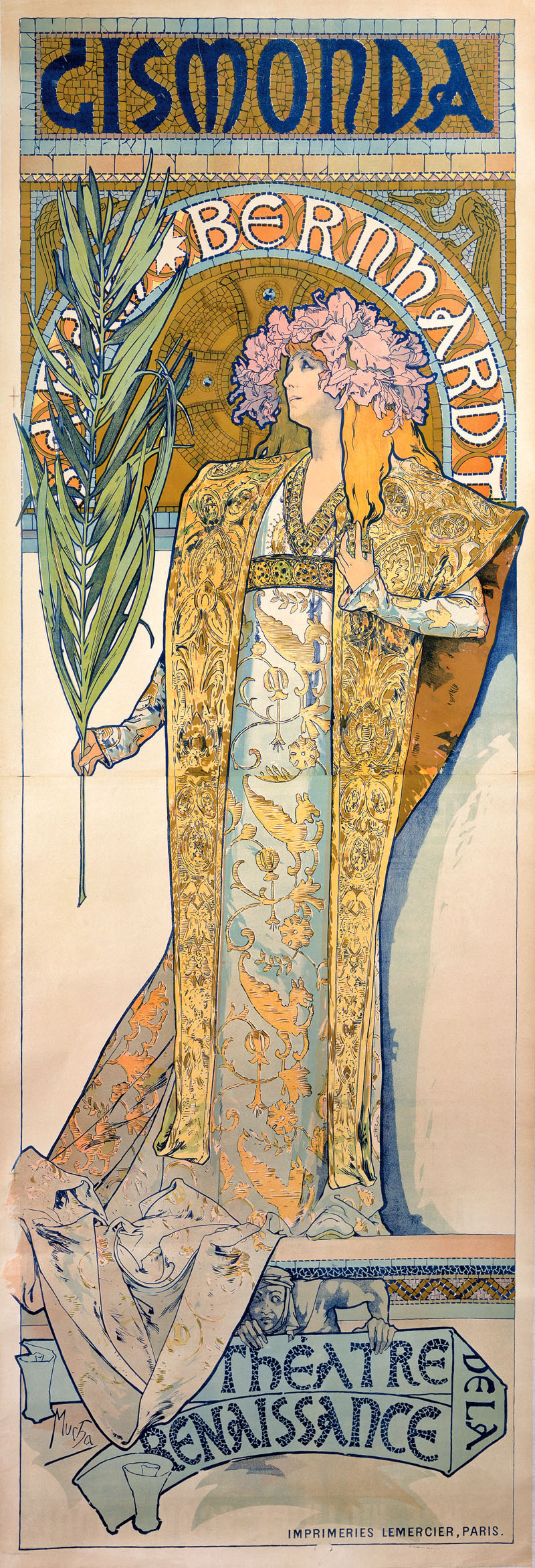NSU Art Museum Fort Lauderdale
February 4 – October 18, 2018
William Glackens, Study for Music Hall Turn, c.1918, oil on canvas, NSU Art Museum Fort Lauderdale; Bequest of Ira D. Glackens,

Alphonse Mucha, Gismonda, 1894, vintage poster, color lithograph, NSU Art Museum Fort Lauderdale; gift of Drs. Walter and Mildred Padow.
NSU Art Museum Fort Lauderdale will present Midnight in Paris & New York: Scenes from the 1890s – 1930s, William Glackens and His Contemporaries
from February 4 through October 18, 2018. Featuring drawings,
paintings and photographs by Eugène Atget, Brassai, William Glackens, André Kertesz, Henri
de Toulouse-Lautrec, Alphonse Mucha, Pablo Picasso, John Sloan, Louis
Comfort Tiffany and others along with
distinctive architectural designs, furniture, glass, metalwork and
silver, this new exhibition offers a fascinating glimpse into the
rapidly changing society of the turn of the century and life in the new
modern city. The Museum’s Sunny Kaufman Senior Curator Barbara Buhler Lynes, Ph.D. curated the exhibition.

William Glackens (1870-1938) : Café de la Paix, c. 1906
William J. Glackens (1870-1938) came of age as an artist in the 1890s, when he distinguished himself as one of America’s most celebrated illustrators. He subsequently became known as an important and leading modernist artist for his lively, realistic depictions of modern life and an important advocate of modern art in America. The years of his creativity from the1890s to the 1930s were marked by dramatic social, political and technological changes that revolutionized the character of cities around the world, such as New York, where the Philadelphia-born Glackens moved in 1896, and Paris, where he lived from 1895-96 and to which he returned many times.
During these decades, the completion of the Eiffel Tower (1889) and the Basilica of Sacré-Coeur
(1914), among other architectural achievements redefined the Parisian
skyline, as did skyscrapers in New York, such as the Flatiron (1902) and
Woolworth (1912) buildings.
The population of both cities surged with the influx of immigrants and people from rural areas, which increased diversity, and led to building booms, the establishment of businesses, and the opening of department stores that acquainted people with the latest fashions, household products and furnishing. Newspapers and illustrated popular magazines flourished and their wide distribution disseminated new ideas and trends. Inventions like the airplane, automobile, escalator, elevator, light bulb, neon, movies, telephone, and radio revolutionized how people communicated, lived, worked and spent leisure time.
The population of both cities surged with the influx of immigrants and people from rural areas, which increased diversity, and led to building booms, the establishment of businesses, and the opening of department stores that acquainted people with the latest fashions, household products and furnishing. Newspapers and illustrated popular magazines flourished and their wide distribution disseminated new ideas and trends. Inventions like the airplane, automobile, escalator, elevator, light bulb, neon, movies, telephone, and radio revolutionized how people communicated, lived, worked and spent leisure time.
Glackens and a group of his American contemporaries first distinguished themselves in the 1900s for their dynamic, realistic depictions of life in the modern city. Like their French contemporaries, they brought the diversity of city dwellers in New York and Paris to life in depictions of actors, dancers, circus performers, celebrations, crowds, immigrants, city streets, and tenements. Their scenes of bars, cabarets, cafes, circuses, dance halls, and theaters reveal how the magic of the electric light bulb transformed nightlife into glittering and colorful spectacles.
Highlighted
in the exhibition is NSU Art Museum's distinctive William J. Glackens
art and archival collection, the largest holding of the artist's work in
the world. Works on loan and from the museum’s collection by Berenice
Abbot, Eugène Atget, William Bradley , Brassaï, Daum, Edith Dimock,
Emile Gallé, William J. Glackens, Jabez Gorham, Hector Guimard, René
Jacques, André Kertesz, Marie Laurencin, George Luks, Henri de
Toulouse-Lautrec, Alphonse Mucha, Pablo Picasso, Maurice Prendergast,
John Sloan, Louis Comfort Tiffany, and Edouard Vuillard add to the
exhibition’s recreation of the ambiance, environment, and historical
context of the dynamic period in which Glackens lived and worked.
The
exhibition features four recent gifts to NSU Art Museum, including
three renowned art nouveau posters by Alphonse Mucha dating from the
1890s to 1908, from Drs. Walter and Mildred Padow, and

William J. Glackens’s Patriots in the Making,1907, from Patricia O’Donnell.

William J. Glackens’s Patriots in the Making,1907, from Patricia O’Donnell.